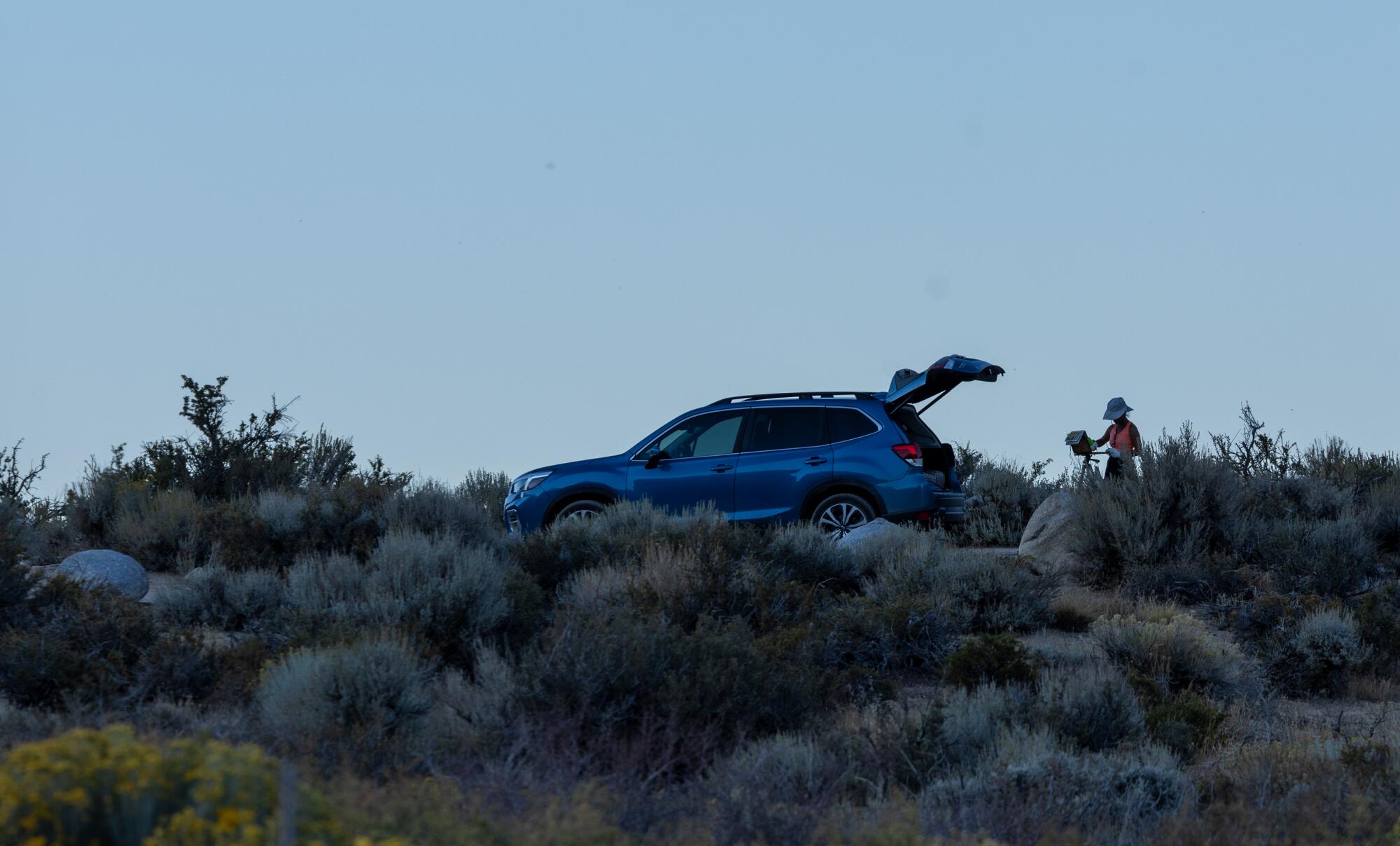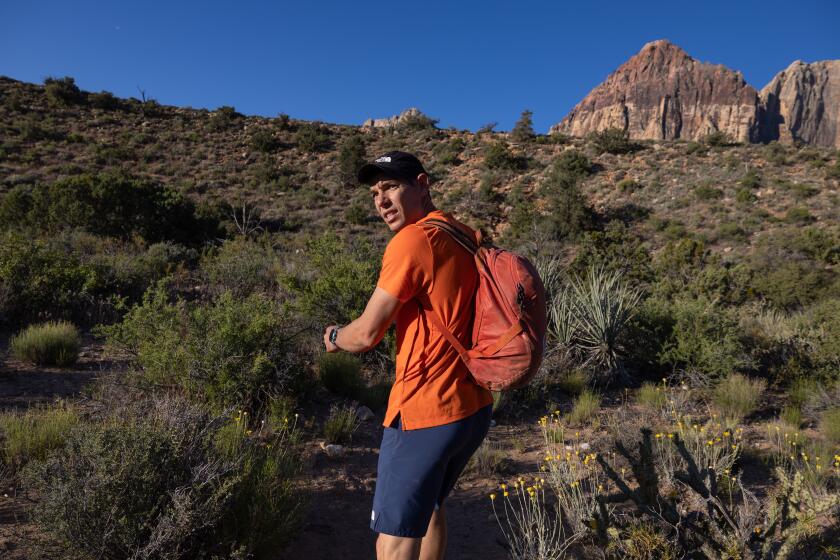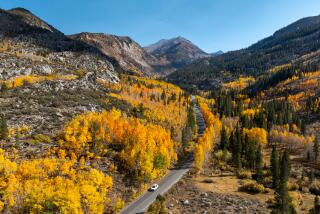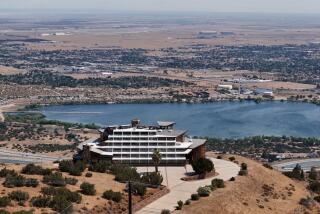
- Share via
MAMMOTH LAKES, Calif. — Emily Markstein, a sinewy rock climber and skier who has spent seven years living and working in the Sierra resort town of Mammoth Lakes, opens a large sliding door and welcomes a stranger into her home.
One of the gleaming multimillion-dollar mansions nestled among towering pine trees and granite peaks in this exclusive mountain enclave? Not exactly.
Markstein, who has a master’s degree in historic preservation and has coached skiing, taught yoga, trimmed trees and waited tables at one of the fanciest restaurants in town, lives in a 2006 GMC van.

Like countless other adventure seekers drawn to California’s rugged and remote Eastern Sierra, Markstein, 31, initially embraced “van life” after scrolling through social media posts that made it look carefree and glamorous. She continues because she genuinely likes it, she said, but also because, even in this big, beckoning land full of wide-open spaces, there’s almost nowhere else for working people to live.
Official statistics are hard to come by, but Markstein spitballs the percentage of hourly workers in Mammoth Lakes who are living in cars and vans as “less than 50 but more than 20.” In every place she’s worked since moving here, she said, “there have been at least two of us living in our vans.”
Like so many others, she tries to hide that uncomfortable truth from tourists so as not to shatter their fantasy about escaping to an untroubled mountain paradise. But it takes effort.
“I had to play the part of the fine dining expert, like, I know my wines and I know good food,” she said with an easy, infectious grin. “But you haven’t showered in a week and a half and you’re putting deodorant on, and all these sprays, trying to make yourself look like you don’t live in your car.”

The notion of an acute housing shortage in this wild and sparsely populated region — there are about four people per square mile in Mono County and fewer than two per square mile in neighboring Inyo County — can be hard to wrap your head around.
It’s due, in large part, to the fact that more than 90 percent of the land is owned by conservation-minded government agencies: the U.S. Forest Service, the federal Bureau of Land Management and, most controversially, the Los Angeles Department of Water and Power.
Those large, distant bureaucracies have little interest in making land available to the fast-growing ranks of outdoor enthusiasts — hikers, climbers, skiers, anglers with fly rods — flocking to this mostly unspoiled part of California near the Nevada border.
So when any sliver of private land or an already existing home hits the market, there’s usually a long line of well-to-do professionals and would-be Airbnb investors from coastal cities ready to drive the price out of reach for even the most industrious working people. As a result, essential workers are left out in the cold.
“That has always been a problem here,” said Mammoth Lakes Mayor Pro Tem Chris Bubser. But it has become noticeably worse since the pandemic, when so many well-paid professionals discovered they could work from anywhere, and so many long-term rental units became Airbnbs to accommodate them.

Now, Bubser said, the lack of affordable housing is a full-blown crisis making it almost impossible for hourly workers, and even some salaried professionals, to keep a traditional roof over their heads.
Last year, the schools made job offers to four teachers, but three had to say no because they couldn’t find anywhere to live, Bubser said.
“Our community is hollowing out, and it’s going to be catastrophic down the line,” Bubser said. “We want people to come and raise a family in this amazing place. It feels terrible that it’s not for everybody.”
The economics of resort towns, where tourists go to play and most everyone local hustles to get by, have been hard on working people for decades. It’s the same in ski towns throughout the American West: Lake Tahoe, Vail, Aspen, Park City.
But the Eastern Sierra’s housing crunch stretches well beyond the confines of Mammoth Lakes.

A 40-minute drive south on U.S. 395 descends more than 3,000 vertical feet to the floor of the Owens Valley and fills your windshield with one of the most sweeping and expansive views in the country. Snowy peaks tumble down to steep granite walls. The walls descend to lush green pastures. The pastures give way to high desert that stretches toward the horizon.
The most breathtaking part? In all of that wide open space, there’s still essentially nowhere to live.
“It’s just insane,” said Jose Garcia, mayor of Bishop, a dusty crossroads of about 3,800 people at the bottom of the hill.
Garcia has lived in Bishop for 35 years and has watched the once-sleepy ranching outpost explode in popularity with adventure-loving tourists: hikers and climbers in the summer, anglers and leaf-peepers in the fall, skiers in the winter. Tourism is by far the biggest industry, he said.

But in all his time there, “the city has not grown at all,” Garcia said.
That’s because almost all of the land in and around Bishop is owned by the Los Angeles Department of Water and Power, Garcia said.
More than a century ago, when it became clear the booming metropolis 300 miles to the south would very quickly dry up its own meager water supplies, its agents fanned out across the Owens Valley, buying up every acre they could find to secure rights to the precious snowmelt that flows down from the mountains each spring.
Today, the DWP owns about 250,000 acres in Inyo County, where Bishop is located.
“We are basically landlocked,” said an exasperated Garcia over coffee earlier this month, as soft morning light bathed the mountains in every direction.
California has a dozen summits higher than 14,000 feet; the trailheads leading to 11 of them are within about an hour of where he sat.
“Bishop would be like Santa Monica” if the city had room to grow, he said. “People would come from all over because of the beauty of this place.”

Adam Perez, the DWP’s top manager in the Owens Valley, said it’s easy to point the finger at his agency and blame it for the stagnation. But the DWP manages the land responsibly, he said. The overarching mission remains what it always was — to send the water down to Los Angeles — but the department works hard to be more than just “bullies that are trying to push people around,” he said.
The agency allows hiking, hunting, fishing and camping on most of its land, he pointed out.
And if you’re lucky enough to own one of the existing houses, he said, you might like the fact that your view across that incredible landscape is never going to be marred by “a big housing tract” plunked down in the middle of it.
“You’re always going to have a protected view,” Perez said.
If Perez is at the top of the local pecking order, the young climbers who flock to Bishop from around the globe to train on world-class crags in Buttermilk Country and the Owens River Gorge are near the bottom.
The Mammoth Gear Exchange, a secondhand sporting goods shop on a corner of Bishop’s main intersection, is a local landmark and regular haunt for climbers. On a recent weekday morning, a handful of the shop’s employees agreed with at least some of what Perez said: They love that Bishop remains so remote and that it hasn’t succumbed to suburban sprawl as have climbing meccas near Denver and Boulder.
But all of them have spent long stretches living out of their vans, even after they decided to give up the itinerant life of a hard-core traveling climber and tried to put down roots.
One, who asked to be identified only by his first name, Peter, to avoid attracting attention from parking enforcement, said he had been living in a van since making the trek from Ohio to California 2½ years ago. His girlfriend lives with him.
They’re in no rush to start paying rent, he said, but it didn’t take much prompting to get him to rattle off a long list of the difficulties.

“When you’ve lived in a house your whole life, you don’t realize how much you value your own space,” he said, choosing his words carefully. Forget about getting anything delivered from Amazon.
“It seems like the whole system is set up” for people who live in houses, he said, “like, you’re supposed to have a permanent address.”
He sounded almost mystical when his thoughts turned to the comforts of indoor plumbing. “Just having warm water to wash your hands on demand,” he said. “Like, you just turn the dial.”
Back up the hill in Mammoth, Markstein’s description of van life also frequently circled back to the issue of plumbing.
“During COVID, I was showering in the creek,” she said, because social distancing requirements made invitations to use indoor bathrooms hard to come by. “Right now, I rotate through my friends’ houses to get my weekly shower.”
Then, realizing how that might sound to an audience of the uninitiated, she added: “For many people that’s pretty gross, but for people living in a van it’s kind of normal.”
With its strip clubs and slot machines, Las Vegas is one of the indoors-iest places on Earth. But just outside the city, elite outdoor athletes are buying homes, starting families and declaring Las Vegas the adventure sports capital of the U.S.
During her stint as a tree trimmer, she guessed about 70% of the properties she worked on sat empty because they were either second homes or unoccupied Airbnbs. That was immensely “frustrating” for someone working her butt off, living in a van, she said.
But maybe nothing is as frustrating for van lifers, or occupies as big a chunk of their daily bandwidth, as the question of where to find a toilet.
At one point, a few of her friends worked at an organic coffee shop on Main St. called Stellar Brew. It had a comfortable, welcoming vibe. Word spread quickly. Before long, Markstein said, she’d go there in the morning and see “10 vans lined up” in the parking lot.
The inside joke was: “Have a stellar poo at Stellar Brew.”

The shop’s general manager, Nikki Lee, had nothing but sympathy and praise for the van lifers.
The housing situation is so precarious for working people in Mammoth, Lee said, she actually prefers job candidates who live in their vans. Their lives are more stable than people engaged in the almost always losing battle of trying to hold on to an apartment in a town where rent is often upward of $4,000 a month and constantly rising.
A current full-time baker at the shop, who used to be a kindergarten teacher, lives in his van, Lee said.
“I don’t ever let that be a deterrent for hiring,” Lee said, “because I know that the folks that live in their van, they can make the commitment to stay.”
More to Read
Sign up for Essential California
The most important California stories and recommendations in your inbox every morning.
You may occasionally receive promotional content from the Los Angeles Times.













